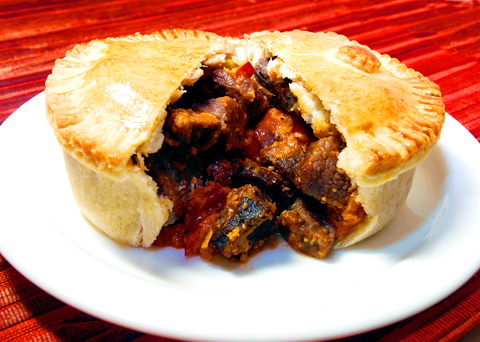Fed up with teaching English, South African expat Frank Thiart quit his job late last year but wasn’t sure what to do next. Within three days he had found the answer — selling pies — and a suitable location for a shop-cum-restaurant in Yunghe City.
His reason: decent pies could only be found in upscale supermarkets, and they are factory-produced and over-priced.
Thiart started off with homemade quiche (NT$60 per slice) and four flavors of pie and has, since opening on March 13, expanded the menu to include hamburgers (NT$80), sausage rolls (NT$70), Hawaiian curry chicken rice (NT$130), which is baked in half of a hollowed-out pineapple and is notable for its sweet aroma and sour flavor, French fries (NT$35), which are coated in a piquant seasoning mix, salad (small NT$40, large NT$60) and more than eight flavors of pie.

PHOTO COURTESY OF FRANKIE'S PIES N' MORE
Generously proportioned — 11cm in diameter and 5.5cm deep — and served in a foil jacket along with a miniscule portion of salad, which prevents them appearing bare, the pies cost between NT$80 for cheese and vegetable to NT$95 for Italian steak. They can be ordered in set meals with a juice (red grape) and fries. The price varies according to which pie is ordered. A second set comprises a slice of quiche, small salad and juice (NT$100).
Pie flavors range from the traditional chicken and cheese, cheese and vegetable, and pepper steak, to the more innovative adobo, inspired by the vinegary Philippine dish of the same name, three-cup chicken (三杯雞), and hamburger variety, the filling of which is made from patty meat, gherkin and barbecue sauce.
A two-floor operation with a spotless kitchen and bathroom on the second, a storefront sporting a glass display case on the first, and three tables and 11 chairs outside on the sidewalk, Frankie’s main trade is in takeouts, which can be taken home, refrigerated and reheated later. A chicken and cheese pie, after one day in the fridge, had retained the crispiness of its golden short-crust pastry top and base, although the sides had turned a tad soggy. Thiart recommends reheating the pies in the oven to crisp up the pastry. Precooked frozen pies are also available.
Three potted plants, a rope light shade, two ceiling fans, cheerful corn yellow and burnt orange walls and a red awning make the seating area a pleasant little spot in what is otherwise a noisy, densely populated suburb. At 10pm on a recent evening there was little traffic on the tree-lined street.
Frankie’s doesn’t serve alcohol, but Thiart said patrons are welcome to bring along their own refreshments.
By MRT, take the blue (Nanshijiao) line to Dingxi Station. From Exit No. 2, Frankie’s is a four-minute walk. Turn left from the station and take a left onto Wenhua Road at the first traffic lights. The pie shop is on the same side of the road, a few blocks up. From Taipei City, take Chungcheng Bridge (中正橋) to Yunghe City. Turn right onto Wenhua Road at the first traffic lights after the bridge. Frankie’s is on the left a few blocks after the lights.
To place an order or obtain a quote for party platters, which Thiart said would be included on the menu in the near future, send an e-mail to frankiespie@gmail.com.

In the March 9 edition of the Taipei Times a piece by Ninon Godefroy ran with the headine “The quiet, gentle rhythm of Taiwan.” It started with the line “Taiwan is a small, humble place. There is no Eiffel Tower, no pyramids — no singular attraction that draws the world’s attention.” I laughed out loud at that. This was out of no disrespect for the author or the piece, which made some interesting analogies and good points about how both Din Tai Fung’s and Taiwan Semiconductor Manufacturing Co’s (TSMC, 台積電) meticulous attention to detail and quality are not quite up to

April 21 to April 27 Hsieh Er’s (謝娥) political fortunes were rising fast after she got out of jail and joined the Chinese Nationalist Party (KMT) in December 1945. Not only did she hold key positions in various committees, she was elected the only woman on the Taipei City Council and headed to Nanjing in 1946 as the sole Taiwanese female representative to the National Constituent Assembly. With the support of first lady Soong May-ling (宋美齡), she started the Taipei Women’s Association and Taiwan Provincial Women’s Association, where she

Chinese Nationalist Party (KMT) Chairman Eric Chu (朱立倫) hatched a bold plan to charge forward and seize the initiative when he held a protest in front of the Taipei City Prosecutors’ Office. Though risky, because illegal, its success would help tackle at least six problems facing both himself and the KMT. What he did not see coming was Taipei Mayor Chiang Wan-an (將萬安) tripping him up out of the gate. In spite of Chu being the most consequential and successful KMT chairman since the early 2010s — arguably saving the party from financial ruin and restoring its electoral viability —

It is one of the more remarkable facts of Taiwan history that it was never occupied or claimed by any of the numerous kingdoms of southern China — Han or otherwise — that lay just across the water from it. None of their brilliant ministers ever discovered that Taiwan was a “core interest” of the state whose annexation was “inevitable.” As Paul Kua notes in an excellent monograph laying out how the Portuguese gave Taiwan the name “Formosa,” the first Europeans to express an interest in occupying Taiwan were the Spanish. Tonio Andrade in his seminal work, How Taiwan Became Chinese,